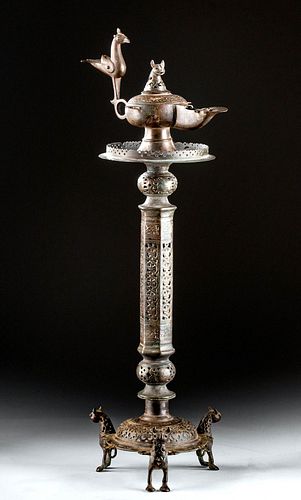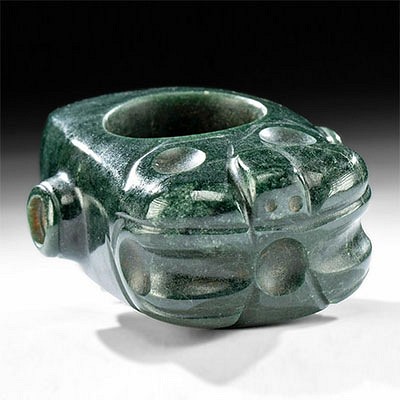12th C. Seljuk Bronze Oil Lamp + Stand w/ Lions
Lot 58a
About Seller
Artemis Fine Arts
686 S Taylor Ave, Ste 106
Louisville, CO 80027
United States
Selling antiquities, ancient and ethnographic art online since 1993, Artemis Gallery specializes in Classical Antiquities (Egyptian, Greek, Roman, Near Eastern), Asian, Pre-Columbian, African / Tribal / Oceanographic art. Our extensive inventory includes pottery, stone, metal, wood, glass and textil...Read more
Categories
Estimate:
$10,000 - $15,000
Absentee vs Live bid
Two ways to bid:
- Leave a max absentee bid and the platform will bid on your behalf up to your maximum bid during the live auction.
- Bid live during the auction and your bids will be submitted real-time to the auctioneer.
Bid Increments
| Price | Bid Increment |
|---|---|
| $0 | $25 |
| $300 | $50 |
| $1,000 | $100 |
| $2,000 | $250 |
| $5,000 | $500 |
| $10,000 | $1,000 |
| $20,000 | $2,500 |
| $50,000 | $5,000 |
| $100,000 | $10,000 |
| $200,000 | $20,000 |
About Auction
By Artemis Fine Arts
Sep 10, 2020
Set Reminder
2020-09-10 10:00:00
2020-09-10 10:00:00
America/New_York
Bidsquare
Bidsquare : Antiquities | Asian | Ethnographic Art
https://www.bidsquare.com/auctions/artemis-gallery/antiquities-asian-ethnographic-art-5546
Featuring classical antiquities, ancient and ethnographic art from cultures encompassing the globe. Egyptian, Greek, Roman, Etruscan, Near Eastern, Asian, Pre-Columbian, Native American, African / Tribal, Oceanic, Spanish Colonial, Russian, Fossils, Fine Art, more! Artemis Fine Arts info@artemisgallery.com
Featuring classical antiquities, ancient and ethnographic art from cultures encompassing the globe. Egyptian, Greek, Roman, Etruscan, Near Eastern, Asian, Pre-Columbian, Native American, African / Tribal, Oceanic, Spanish Colonial, Russian, Fossils, Fine Art, more! Artemis Fine Arts info@artemisgallery.com
- Lot Description
Near East, probaby made in Khorassan, northeast Persia (Iran), Seljuq (Saljuq/Seljuk) period, ca. 12th to 13th century CE. A fantastically preserved bronze oil lamp with a stand and base, composed of four parts that easily fit together to create a fabulous whole. You can easily imagine this piece gracing a sumptuous medieval Persian home - perhaps that of a prosperous merchant or high ranking advisor to the sultan. The first component is the lamp itself, with a flaring foot, rounded body, long spout with leaf-shaped mouth, lid in the form of an openwork lion's bust, and handle with a bird with a flaring tail perched atop it. Stylized interlocking Arabic script flows around the shoulder and the foot. Size: 11.75" W x 28" H (29.8 cm x 71.1 cm)
The second component is a bowl that the lamp sits inside of, with a wide, concave base and a low crenellated barrier around its edge, presumably for catching any oil that might drip from the lamp. The third component is the leg of the stand, an openwork hexagonal column with round openwork spheres at top and bottom so that it resembles a minaret. Floral motifs and stylized Arabic cover its surface in relief. This sits atop the fourth component, the foot of the lamp, which has three feet, each in the form of the front half of a lion. The openwork body of the foot also has scroll and floral motifs around it and on the necks of the lions, who stand at attention in a way reminiscent of the lions at the famous fountain in the Court of the Lions at the Alhambra - made by the Seljuq's Islamic world contemporary, the Nasrid Dynasty.
From the earliest known art of this region, lions - portrayed as lionesses, without manes - symbolized both power and hunting, the pursuit of elites. During the Seljuq period, there was a huge market in bronze secular items, part of a luxury trade in the marketplaces of the Levant. They were made to appeal to consumer taste, including Christians, Muslims, and people with little interest in religious art. As a result, scenes of court life, battle, and hunting - as this piece is probably a reference to - were popular.
A very similar but less ornate lamp and lampstand sold for GBP 22,500 (approximately USD 40,000) in 2011 in London: https://www.christies.com/lotfinder/Lot/a-large-khorassan-bronze-lampstand-north-east-5482966-details.aspx
Provenance: private California, USA collection, by descent, moved from Germany in 1997, originally collected in the 1970s in Hamburg, Germany
All items legal to buy/sell under U.S. Statute covering cultural patrimony Code 2600, CHAPTER 14, and are guaranteed to be as described or your money back.
A Certificate of Authenticity will accompany all winning bids.
We ship worldwide and handle all shipping in-house for your convenience.
#148839This is in four parts that easily separate. Rich patina on all four components. Lamp has a few small indentations. Lid is still functional. Small tear near one leg on the base. Light deposits on all surfaces.Condition
- Shipping Info
-
All shipping is handled in-house for your convenience. Your invoice from Artemis Gallery will include shipping calculation instructions. If in doubt, please inquire BEFORE bidding for estimated shipping costs for individual items.
-
- Buyer's Premium



 EUR
EUR CAD
CAD AUD
AUD GBP
GBP MXN
MXN HKD
HKD CNY
CNY MYR
MYR SEK
SEK SGD
SGD CHF
CHF THB
THB















